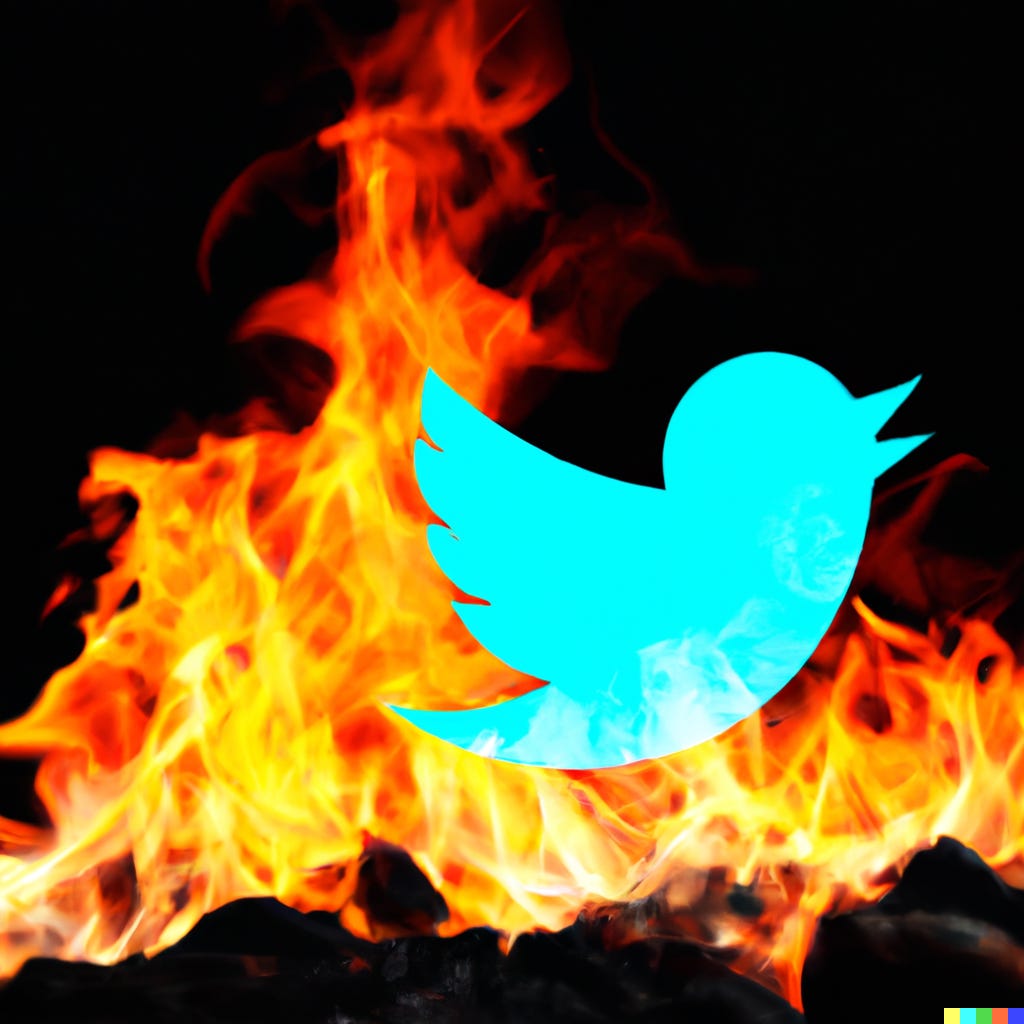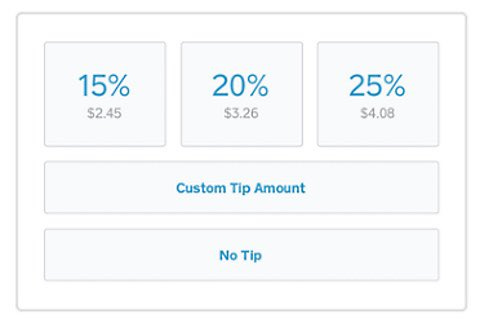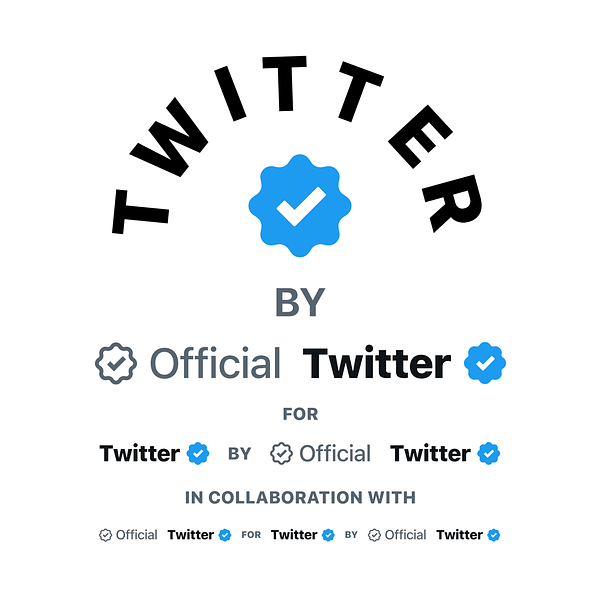Platformer - Inside the Twitter meltdown
Here’s a second free edition of Platformer for the week — more scoops about a day when Twitter truly melted down, with an exodus of executives that leaves the future of platform in real doubt. We had originally intended to make this a paid update, but we think the future of Twitter is important enough that we want to ensure as many people can follow along as possible. But there’s real value in upgrading your subscription: In recent days, subscribers have gotten timeline-shaking scoops about Musk ordering employees to print out their code and his plans to charge verified users to keep their badges. We also wrote the definitive account of Twitter’s layoffs last week. If you value this work, it would mean a lot to us if you bought a monthly or annual subscription. Subscribe now and we’ll send you the link to join us in our chatty Discord server, where we’ve been flagging fake “verified” accounts all day.
Everything went from bad to worse at Twitter on Thursday. Today let’s talk about a truly chaotic 24 hours at the company, and the mounting fears over what it means for the service that still serves as the heartbeat of the global news cycle. I. On Wednesday morning, amid mounting concerns from advertisers that the new Twitter would not prove to be a safe home for brands, Elon Musk held an hour-long Spaces call designed to reassure them. Joining Musk on the call were his head of trust and safety, Yoel Roth, a seven-year veteran of the company who had served as a steady hand during a tumultuous transition; and Robin Wheeler, the company’s de facto head of sales, who had spent a decade selling ads for the company across several key roles. On the call Musk performed his usual routine, offering a scattershot set of product announcements that were almost certainly news to the people who would soon be called upon to build them. Soon the timeline would comprise mostly tweets from paid subscribers, he said, with the rest relegated to a zone comparable to Gmail’s spam filter. The site would soon enable … longer video downloads? And, of course, Twitter would remain brand-safe: pressuring users to subscribe, he said, would (somehow) reduce the number of bots and spam on the site, making the service more welcoming to advertisers. A day later, Roth and Wheeler were gone, the company’s new verification scheme had introduced a variety of serious new brand risks onto the platform, and a company that had already been battered by massive layoffs had lurched into a fresh crisis. Today let’s talk about the events that set this crisis into motion. II. The dramatic unwinding of the company’s senior ranks began overnight, in the hours after Twitter’s new owner made his first official communication to the entire company. The email came at 11:39 PM PT, long after most employees around the world had gone to bed. “Sorry that this is my first email to the whole company,” Musk began, “but there is no way to sugarcoat the message.” The message: that Twitter’s future is “dire,” Musk wrote, an effect of a worsening economy and the company’s dependence on brand advertising. “Without significant subscription revenue, there is a good chance Twitter will not survive the upcoming economic downturn. We need roughly half of our revenue to be subscription.” Musk linked to the Spaces he had held with Roth and Wheeler, and ended with a bombshell: every remaining Twitter employee was expected to return to their offices to work beginning Thursday. (“Obviously, if you are physically unable to travel to an office or have a critical personal obligation, then your absence is understandable,” he added.) Seventeen minutes later, Musk followed up with a one-sentence email to the team labeled “Top Priority.” “Over the next few days,” he wrote, the absolute top priority is finding and suspending any verified bots/trolls/spam.” Over the next few hours, Twitter employees began to wake up to the news. It had been paired with another change, announced elsewhere, in the company’s 2023 benefits package: the same day Twitter told employees to return to the office after telling them last year they could work remotely forever, Twitter ended its practice of giving a commuter subsidy to employees outside of California. “What is the guidance for tweeps with children and other dependents who need to arrange childcare etc?” one employee asked in a Slack channel. “These are not arrangements that can realistically be changed at a moment’s notice, for example enrolling in daycare, hiring nannies, arranging managed care facilities, etc. This new policy seems designed to penalize parents, guardians, and other caregivers who may have designed their whole lives around full or partial remote work.” No guidance was forthcoming, though. III. About six or so hours later, a lawyer on Twitter’s privacy policy posted a rebuttal to Musk on the company’s Slack. “Twitter is a remote-first workplace, and has operated as such for years,” wrote the attorney, whose name Platformer is withholding to protect their privacy. “It is a fundamental change to our employment contracts to require a 40hr a week in-office requirement. I do not, personally, believe Twitter employees have an obligation to return to office. Certainly not on no notice at all.” We checked in with Vincent P. White, a labor lawyer in New York, who said if Twitter employees were promised remote work in their contracts, Musk’s order could constitute a breach of contract, and they’d have grounds to sue. But he doubted whether the contract language was that strong. “Simply calling a position remote isn’t necessarily enough to make it binding,” he said. In the internal note this morning, the Twitter lawyer offered another jolting bit of news: as Platformer was first to report, its chief privacy officer, Damien Kieran; its chief information security officer; Lea Kissner; and its chief compliance officer, Marianne Fogarty, had all resigned. As if that weren’t concerning enough, the lawyer reported that Twitter appeared poised to de-prioritize various privacy and safety considerations, likely in violation of a consent decree that the company has with the Federal Trade Commission. The Verge posted the entire note. The attorney wrote:
The attorney, who said they would be taking the remainder of the day off, ended with a link to Whistleblower Aid, and encouraged any employee who felt uncomfortable with what the Musk regime had asked them to do to call the FTC directly. (Around 4PM, Musk emailed the staff to say “Twitter will do whatever it takes to adhere to both the letter and spirit of the FTC decree.”) IV. Just after lunchtime on the West Coast, Musk held an unannounced all-hands meeting with staff — his first as CEO. Musk had given employees just one hour’s notice; he arrived 15 minutes late. Over the next hour Musk shared more bad news with the company. Depending on the length and severity of the recession, he said, the company could lose several billion dollars next year. He would not speculate how much runway Twitter had left. “Bankruptcy isn’t out of the question,” he said, as we were also first to report. Around that time, someone put a poll into Twitter’s Slack channel: “Is it too early for vodka?” the poll asked. (It was a little after 1PM PT.) Musk also took a pugnacious tone with employees who questioned the wisdom of a forced return to the office. Speaking of the value of in-person work, he said: “If you can physically make it to an office and you don’t show up, resignation accepted.” Those last two words would loom larger in the hours afterward, when Roth and Wheeler indeed tendered their resignations. So did John Debay, director of software engineering. That left massive holes in the product, trust and safety, and sales organizations, further increasing the difficulty for Musk as he attempts to retain and recruit advertisers. That difficulty of growing the ad business had already been increased by Musk’s decision, against the advice of many employees on his team, to proceed with an ill-considered plan to make verification checkmarks available to anyone willing to pay $8 for a subscription to Twitter Blue. The flaws in the plan were numerous, and obvious. Ever since the white-on-blue checkmark was introduced in 2009, it has signified that the account belongs to who it says it belongs to. The process has always been flawed, and was ripe for an overhaul, but at least the badge’s meaning has been clear. Musk insisted on re-using that same checkmark, but applied no requirements to who could ask for one. As a result, like clockwork, as soon as the new program rolled out yesterday people began to abuse it. A fake but “verified” account for Eli Lilly tweeted: “We are excited to announce insulin is free now,” forcing the real Eli Lilly to respond that (alas) no it isn’t. A fake but “verified” basketball journalist tweeted falsely that the controversial player Kyrie Irving had been released. A fake but “verified” Canadian Broadcasting Company account appeared. There was also, inevitably, a fake but “verified” Tesla account, and you can probably guess the kind of thing it tweeted. It wasn’t exactly mayhem — you can imagine worse uses of this technology — but at the very least it hinted of darker abuses to come. V. One of Musk’s other ideas, discussed during his Spaces event Wednesday, was to turn Twitter into a payments company. “Now we can say like, OK, you’ve got a balance on your account, do you want to send money to someone else within Twitter?” Musk said, as transcribed by CNBC. “And maybe we pre-populate their account with and say, OK, we’re gonna give you 10 bucks, and you can send it anywhere within Twitter.” The company has been working to make that a reality. On Nov. 4 the company named Esther Crawford, who has been leading the rollout of the new Blue, CEO of Twitter Payments, according to a screenshot viewed by Platformer. The company is currently seeking a money transmitter license in Washington, according to the message. It seems likely that work will be hampered by Thursday’s exodus of employees. It’s difficult to imagine a the company launching a payments business without competent executives working on privacy, information security, compliance, and other functions that the company lost today. Platformer has also learned that much of the security governance risks and compliance team has left — leaving Twitter with few employees to gather documents and evidence should the FTC come calling. On one hand, the situation is moving so quickly at Twitter that any predictions seem especially unwise. On the other, a real sense of doom began to pervade the timeline today, as some users began to ponder for the first time a world with a defunct or deserted Twitter. Musk’s whim-based approach to product development, his rapidly depleting executive ranks, and the very real likelihood of hundreds or even thousands of additional departures at the company in coming weeks threaten to leave Twitter a shadow of its former self. And much of the reason for that is Musk himself: the way he treated his employees and the product they built; the sage advice he ignored; the business fundamentals that he misunderstood. Musk’s takeover of the company had been so brutish and poorly planned that, we’re told, there was not even a proper handover of the company’s social accounts. As a result, having spent $44 billion to acquire Twitter, for his first week-plus of owning the company, Musk and his team were unable even to tweet from the @twitter account. The team finally managed to access the account on Wednesday, sources tell us. But @twitter has been silent since October 13. And with the way things are going, people are beginning to contemplate a world in which Twitter at large goes silent as well. On the podcast this week: We attempt to stay on top of the Twitter news, even as fresh events continually overtake us. Kevin explains the FTX implosion to me. And amid mounting layoffs across tech, we ask whether regulators will change their opinion about whether Meta is still public enemy No. 1. Apple | Spotify | Stitcher | Amazon | Google Governing
Industry
Those good tweets this is what I get for trying to make education accessible  megan @chismosavirus Talk to usSend us tips, comments, questions, and additional mess: casey@platformer.news and zoe@platformer.news. By design, the vast majority of Platformer readers never pay anything for the journalism it provides. But you made it all the way to the end of this week’s edition — maybe not for the first time. Want to support more journalism like what you read today? If so, click here: |
Older messages
Musk discusses putting all of Twitter behind a paywall
Tuesday, November 8, 2022
Will he go through with it? PLUS: Botched layoffs, how the new Blue could lose money, and more
Twitter, cut in half
Friday, November 4, 2022
💙🫡
Inside Twitter’s product roadmap under Musk
Thursday, November 3, 2022
A new Vine camera is in. Notes and Revue are out
Twitter braces for layoffs
Tuesday, November 1, 2022
Behind the scenes at the wildest tech takeover ever
Elon's first big move: pay to remain verified on Twitter
Sunday, October 30, 2022
Under pressure to generate revenue quickly, Twitter's new CEO considers ending free verification
You Might Also Like
🗞 What's New: Why AI can't replace my $1k/mo human assistant
Saturday, March 8, 2025
Also: 25+ AI agent opportunities ͏ ͏ ͏ ͏ ͏ ͏ ͏ ͏ ͏ ͏ ͏ ͏ ͏ ͏ ͏ ͏ ͏ ͏ ͏ ͏ ͏ ͏ ͏ ͏ ͏ ͏ ͏ ͏ ͏ ͏ ͏ ͏ ͏ ͏ ͏ ͏ ͏ ͏ ͏ ͏ ͏ ͏ ͏ ͏ ͏ ͏ ͏ ͏ ͏ ͏ ͏ ͏ ͏ ͏ ͏ ͏ ͏ ͏ ͏ ͏ ͏ ͏ ͏ ͏ ͏ ͏ ͏ ͏ ͏ ͏ ͏ ͏ ͏ ͏ ͏ ͏ ͏ ͏ ͏ ͏ ͏ ͏ ͏ ͏
What’s 🔥 in Enterprise IT/VC #436
Saturday, March 8, 2025
Debating the future of SaaS + what many VCs are thinking... ͏ ͏ ͏ ͏ ͏ ͏ ͏ ͏ ͏ ͏ ͏ ͏ ͏ ͏ ͏ ͏ ͏ ͏ ͏ ͏ ͏ ͏ ͏ ͏ ͏ ͏ ͏ ͏ ͏ ͏ ͏ ͏ ͏ ͏ ͏ ͏ ͏ ͏ ͏ ͏ ͏ ͏ ͏ ͏ ͏ ͏ ͏ ͏ ͏ ͏ ͏ ͏ ͏ ͏ ͏ ͏ ͏ ͏ ͏ ͏ ͏ ͏ ͏ ͏ ͏ ͏ ͏ ͏ ͏ ͏ ͏
🎯 Fix your fulfillment, fix your profits
Saturday, March 8, 2025
The answer to higher profits is not always selling more. This is how smart businesses do it… Hey Friend , Most ecommerce founders focus on selling more to increase profits. But what if I told you that
Create a social media strategy in 7 (straightforward) steps
Friday, March 7, 2025
Plus, the latest from the blog and social media ͏ ͏ ͏ ͏ ͏ ͏ ͏ ͏ ͏ ͏ ͏ ͏ ͏ ͏ ͏ ͏ ͏ ͏ ͏ ͏ ͏ ͏ ͏ ͏ ͏ ͏ ͏ ͏ ͏ ͏ ͏ ͏ ͏ ͏ ͏ ͏ ͏ ͏ ͏ ͏ ͏ ͏ ͏ ͏ ͏ ͏ ͏ ͏ ͏ ͏ ͏ ͏ ͏ ͏ ͏ ͏ ͏ ͏ ͏ ͏ ͏ ͏ ͏ ͏ ͏ ͏ ͏ ͏ ͏ ͏ ͏ ͏ ͏ ͏ ͏ ͏ ͏
10words: Top picks from this week
Friday, March 7, 2025
Today's projects: Wallpaperee • Chatbox • DesignLit • PH Deck • ChatPro AI • Opencord.AI • NexaAI • GReminders • Springs • crimalin • SuperCarousels • TitleSprint 10words Discover new apps and
Experiment Report: Trying New Things — The Bootstrapped Founder 380
Friday, March 7, 2025
When I talked to Anne-Laure Le Cunff earlier this week, we get into experiments and how to run them effectively. Here's what I've been doing. ͏ ͏ ͏ ͏ ͏ ͏ ͏ ͏ ͏ ͏ ͏ ͏ ͏ ͏ ͏ ͏ ͏ ͏ ͏ ͏ ͏ ͏ ͏ ͏ ͏ ͏
📍Why global trade tariffs might actually boost your ecommerce profits
Friday, March 7, 2025
The best ecommerce brands are now using these trade shifts to their advantage Hey Friend , If you think global tariffs and rising costs are bad for your ecommerce business, think again. Yes, some
Checkout.com in the spotlight
Friday, March 7, 2025
+ German AI startups to watch; Klarna edges to IPO View in browser Powered by Deel Author-Freya Author-TomM by Freya Pratty and Tom Matsuda Good morning there, Guillaume Pousaz, the founder of multi-
Google's new AI Mode is a preview of the future of search
Friday, March 7, 2025
The next phase of AI's takeover of search offers plenty of links to the web — but will anyone click? Platformer Platformer Google's new AI Mode is a preview of the future of search The next
🗞 What's New: The gold rush for AI game development
Thursday, March 6, 2025
Also: Play our daily startup-themed crossword! ͏ ͏ ͏ ͏ ͏ ͏ ͏ ͏ ͏ ͏ ͏ ͏ ͏ ͏ ͏ ͏ ͏ ͏ ͏ ͏ ͏ ͏ ͏ ͏ ͏ ͏ ͏ ͏ ͏ ͏ ͏ ͏ ͏ ͏ ͏ ͏ ͏ ͏ ͏ ͏ ͏ ͏ ͏ ͏ ͏ ͏ ͏ ͏ ͏ ͏ ͏ ͏ ͏ ͏ ͏ ͏ ͏ ͏ ͏ ͏ ͏ ͏ ͏ ͏ ͏ ͏ ͏ ͏ ͏ ͏ ͏ ͏ ͏ ͏ ͏ ͏ ͏







